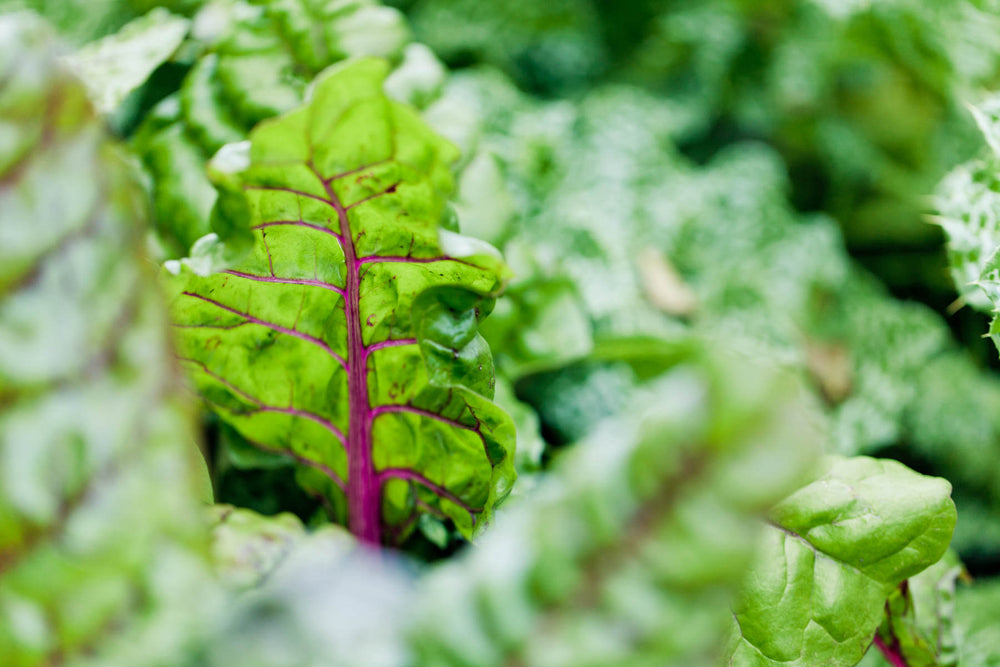Colourful stems and bright green leaves make Swiss chard the single most glamorous garden green as well as a nutritious vegetable. Because it does not ship well, you are not likely to find it at the grocery store. Growing Swiss chard yourself is the only way to have beautiful leaves like these. Fortunately, it is easy to grow in the ground or in containers—especially when you begin with strong, vigorous Bonnie Plants® Swiss chard starter plants—and is one of the few greens that tolerates both cool weather and heat. It will linger in the spring garden much longer than mustard, turnips, arugula, or other greens with the tendency to bolt. In the fall, it grows well until killed by a hard freeze.
Quick Guide to Growing Swiss Chard
- Plant Swiss chard in the spring, 2 to 4 weeks before the last frost date. These colorful, nutritious plants grow well in raised garden beds, containers, and in-ground gardens.
- Space Swiss chard 12 to 18 inches apart in nutrient-rich, well-drained soil with a pH of 6.0 to 6.8.
- Get your growing season off to a great start by mixing in several inches of aged compost or other rich organic matter into your native soil.
- Leafy vegetables need an abundant water supply to grow, so be sure to give them 1 to 1.5 inches of water weekly.
- Make the most of your food-growing efforts by feeding plants with a continuous-release plant food.
- Harvest Swiss chard any time the leaves are large enough to eat. Young leaves will be more tender and flavorful.
Soil, Planting, and Care
Set out plants 2 to 4 weeks before the date of the last frost in spring. A spring planting will go on producing through spring, summer, and fall. For fall gardens, set out plants just about anytime in late summer when they begin appearing at your favorite garden center. Plants tolerate heat well as long as you keep them properly watered.
Growing Swiss chard works best in rich, moist soil with a soil pH between 6.0 and 6.8. Plant about 12 to 18 inches apart in fertile soil, watering directly after planting. Work nitrogen-rich organic matter such as blood meal, cottonseed meal, feather meal, or composted manure into the ground before planting, or improve your existing soil by mixing in aged compost-enriched Miracle-Gro® Performance Organics® All Purpose In-Ground Soil with the top few inches of native soil. You can also plant Swiss chard in pots. Fill them with a premium quality potting mix like Miracle-Gro® Performance Organics® All Purpose Container Mix, which also contains nutrient-rich compost. For best results, you'll also want to fertilize your plants regularly with a continuous-release plant food, such as Miracle-Gro® Performance Organics® Edibles Plant Nutrition Granules, according to label directions.
Like all vegetables, Swiss chard does best with a nice, even supply of water. Water regularly, applying 1 to 1.5 inches of water per week if it doesn't rain. You can measure the amount of water with a rain gauge in the garden. Apply organic mulch such as compost, finely ground leaves, wheat straw, or finely ground bark to keep the soil cool and moist and to keep down weeds. Mulching will also help keep the plant leaves clean, reducing the risk of disease.
There's also the option of growing Swiss chard indoors. One of the easiest ways to do that is with a hydroponic system like the Miracle-Gro® Twelve™ Indoor Growing System, which ensures your plants get everything they need to flourish: moisture, nutrition, light, and air. Instead of growing in soil, plants grow directly in circulating water—which delivers nutrition right to the roots—with a grow light right above them to act as "sunlight."
Troubleshooting
Plants are generally problem free but may be attacked by aphids, mites, or caterpillars that chew holes in the leaves. Swiss chard is also subject to cercospora leaf spot, a disease that disfigures the leaves with ash-gray spots that have purple edges; or leaves may get downy mildew, which causes a mildew-like growth on the foliage. For advice on how to handle pests and diseases in the garden, contact your local Extension agency.
Harvest and Storage
You can begin harvesting outer leaves anytime that they are large enough to eat; young tender leaves are the most flavourful and make a colourful addition to salads. Cut out the midrib of larger leaves before cooking or chopping into salads. Chop large leaves to cook down like spinach, or use in casseroles, soups, and pasta.
In areas that never experience a hard freeze, Swiss chard sometimes behaves like a perennial, living for several years. When it blooms, you can cut off the bloom stalk and it will produce more leaves.
Whole harvested leaves will keep in the refrigerator for about 2 weeks in a loose plastic bag or sealed container.



FAQs
Is Swiss chard cold hardy?
Yes, it will tolerate light frosts. It is not as freeze tolerant as collards and kale, but will certainly make through the first early frosts of the season when the temperature is not too low and doesn't stay below freezing but a few minutes in the wee hours.
I thought that Swiss chard was for cool weather, but I saw it at a botanical garden this summer. Was this a special type?
No, it was probably not any special type. Of all the greens, Swiss chard is certainly the most tolerant of heat. It continues producing leaves through summer, but the quality of the leaves - both flavor and texture - is best in cool weather.
Will Swiss chard grow in pots?
It is perfect for pots because it is tidy and you can just keep picking the outer leaves to let the center ones grow. It is also very pretty in a container because of its colorful stems. Combine with lettuce and flowers such as marigolds or pansies.




 Herbs
Herbs
 Vegetables
Vegetables
 Fruit
Fruit
 Flowers
Flowers
 Succulents
Succulents


